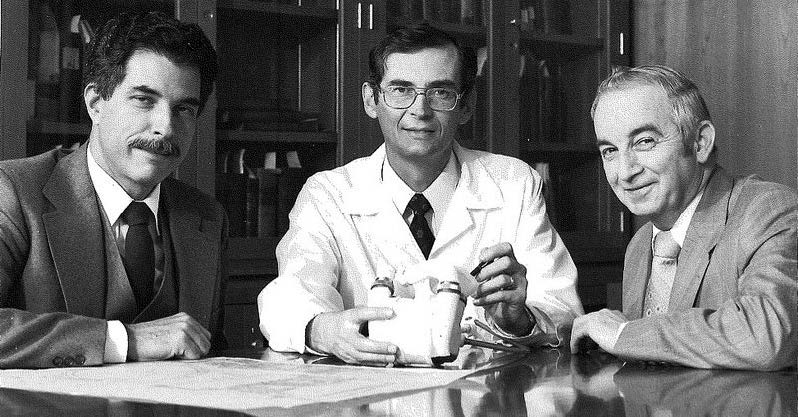Learn more about Penn State’s reputation as an international leader in the research, development and clinical use of heart pumps and artificial hearts.
Penn State Cardiac Research Timeline
- 2016: In November, Dr. John Boehmer, professor of medicine, Penn State College of Medicine, presented findings on a suite of sensors that can predict heart failure events by detecting when a patient’s condition is worsening at the American Heart Association annual meeting. Read more.
- 2015: Dr. Behzad Soleimani implanted the first 50cc SynCardia Total Artificial Heart in the United States in the investigational device exemption trial, the 18th implant worldwide. Read more about the Total Artificial Heart.
- 2008: Penn State Heart and Vascular Institute’s ventricular assist device program becomes one of only a handful of programs nationwide to earn the Joint Commission’s Gold Seal of Approval for implanting VADs as destination therapy for patients with advanced heart failure.
- 2003: In November, the first results of the Arrow LionHeart European research study led by Walter Pae Jr., MD, are unveiled at the American Heart Association’s 76th Scientific Sessions. The study suggests that fully-implantable mechanical heart support is possible and reliable. Only three device failures were recorded in 17.3 years of support time.
- 2001: A phase I research study begins on LionHeart, a Penn State-developed left ventricular heart assist system for heart-failure patients who are not candidates for transplantation. It was developed in conjunction with Arrow International of Reading, Pa. Penn State also began working with Abiomed Corp. on the AbioCor electrical artificial heart.
- 1999: A patient on the Pierce-Donachy pump goes home with a newly approved portable power unit. The patient is able to wait at home for a transplant.
- 1992: Winston the calf ushers in the era of the wireless, electric total artificial heart, living 118 days on the Penn State device.
- 1990: The Pierce-Donachy pump is named an International Historic Mechanical Engineering Landmark by the American Society of Mechanical Engineers.
- 1985: The Penn State Heart is first implanted in a patient.
- 1976: William S. Pierce, MD, attaches the first Penn State air-driven heart pump (later known as the Pierce-Donachy pump) to a post-op patient who was having trouble coming off the heart-lung machine. The patient survives and returns home.

Three members of the interdisciplinary team that developed the heart-assist pump, from left: Gerson Rosenberg,
Dr. William S. Pierce, and James H. Donachy (1992).
Heart-Assist Device History
The Division of Cardiothoracic Surgery was one of the earliest surgical divisions established at Penn State Health Milton S. Hershey Medical Center in the 1970s. Dr. John A. Waldhausen, the Department of Surgery’s founding chairman, asked a young University of Pennsylvania School of Medicine graduate, Dr. William S. Pierce, to join the ranks of new faculty. He tasked Pierce with establishing the division, as well as developing a heart research program that included an animal research facility.
The Penn State Heart-Assist Pump, a pneumatic device, began development under Pierce’s tenure. Initial collaborative efforts included the faculty of both the Penn State College of Medicine and Penn State College of Engineering. Pierce proved to be the driving force in developing a multidisciplinary group for the design, fabrication, and evaluation of heart assist pumps and the artificial heart. Pierce’s team included Gerson (Gus) Rosenberg, a mechanical engineering graduate student, and Penn State mechanical engineers John Brighton and Winfred Phillips, along with a fabrications specialist, James H. Donachy.
In 1976, the team’s efforts proved invaluable when Pierce attached the pump to the heart of a young woman not able to come off of the heart-lung machine following an open-heart surgical procedure. The moment the device was connected, her heart began pumping blood. Within a matter of days her heart had recovered sufficiently that she could be removed from the machine and discharged home.
By the 1980s, medical facilities across the nation were requesting the Penn State Heart-Assist Pump. The team pushed forward to further perfect the device and commercialize it for implantation. It proved instrumental to those who could use it as a “bridge” to sustain their weakened heart while awaiting transplantation. By 1984 the device was in wide-spread use.
The American Society of Mechanical Engineers designated the pump as an International Historic Mechanical Engineering Landmark in 1990. By that time the device had already provided circulatory support for over 250 patients without a single device-failure-related fatality. The Penn State Heart-Assist Pump’s design and operating principles created a solid foundation for heart-assist research at Penn State and elsewhere, ultimately saving lives and significantly improving the quality of life for many.
